#Margaret audley
Explore tagged Tumblr posts
Text
Margaret Douglas, Countess of Lennox, who as Margaret of Scotland's daughter was next in blood, was expected to bear Elizabeth's train, but if Il Schifanoya's account is accurate, there was a last-minute change of plan, and the Duchess of Norfolk was chosen instead.
Word of a Prince, Maria Perry
3 notes
·
View notes
Text
MARGARET AUDLEY, DUCHESS OF NORFOLK: ANOTHER DUDLEY WOMAN
Introducing Margaret Audley, Duchess of Norfolk, wife of Lord Henry Dudley, (known throughout his short life as 'Harry Dudley').

Margaret was born in 1540, the eldest daughter of Thomas Audley, the Lord High Chancellor of England during the reign of Henry VIII, and his second wife, Lady Elizabeth Grey, the elder sister of Henry Grey, 3rd Marquess of Dorset (later the 1st Duke of Suffolk).


Margaret became a ward of Edward VI in 1549, following the death of Sir Anthony Denny, to whom her wardship had been given following her father's death in 1544. Given John Dudley, 1st Duke of Northumberland's position within the regency council, as Lord President, towards the end of his reign, it is likely that aged around 13, she was married to Dudley's youngest surviving son, Harry, in late Spring/early Summer 1553. There were a round of weddings and betrothals at this time, including Margaret's cousin Jane Grey to Harry's elder brother Guildford Dudley, in attempts to secure political alliances in preparation for an inevitable upcoming regime change. Margaret was also a wealthy heiress, due to inherit many of her late father's properties in Hertfordshire, Oxfordshire and Essex, including Walden Abbey, which would also be an attractive prospect for the Dudley family, eager to expand their power.

Harry, along with his elder brothers, was imprisoned in the Tower of London following the failed coup to place Margaret's cousin Lady Jane Grey on the English throne in Jul 1553, and in Nov 1553 was found guilty of high treason and sentenced to death. However, he escaped the fate of his older brother Guildford and his young wife, and with brothers John, Ambrose and Robert was released from the Tower in Oct 1553. Having been pardoned by Mary I, Harry subsequently died at the Siege of Saint-Quentin, France in Aug 1557, aged "20 and a half years" (according to his portrait).

The following year, Margaret was betrothed to Thomas Howard, 4th Duke of Norfolk; however, there were delays in the marriage, due to the need to obtain papal dispensation (Norfolk's previous wife was a cousin of Margaret's). However, following the death of Mary, the accession of Elizabeth I and the abandonment of Catholicism in England, the marriage went ahead in late Nov/early Dec 1558. The new Duchess of Norfolk had a role in the coronation of Elizabeth the following month.
Margaret died in Norwich in Jan 1564, a few weeks following the birth of her youngest child; she had left Walden Abbey, and was said to be making her way back to London, reportedly eager to be reunited with her husband, when her health began to fail, and she succumbed to her illness.
Margaret's eldest son, Thomas Howard, 1st Earl of Suffolk, later inherited Walden Abbey, embarked on a major building project, demolishing the older extended house, and constructing an impressive Jacobean house, renamed as 'Audley End', reportedly costing £200,000. He would later be imprisoned in the Tower of London on charges of embezzlement, and would die at Audley End in debt and disgrace.

Her widower, the Duke of Norfolk, would be executed in 1571 at the Tower of London after being convicted of high treason, for his role in the 'Ridolfi Plot' - a Catholic Conspiracy to remove Elizabeth from the English throne, and replace her with the Scottish Catholic queen, Mary Queen of Scots.
#tudor england#tudor history#history#tudor people#elizabeth i#tudor#tudor women#tudors#Margaret audley#Thomas audley#Elizabeth grey#Henry grey#lady Jane grey#Jane grey#Guildford dudley#harry dudley#Henry dudley#Robert dudley#Ambrose dudley#tower of london#Thomas howard#walden abbey#Audley end
1 note
·
View note
Text
Scandal in Salisbury
Recently I had a rare opportunity to visit Church House in Salisbury. Used for administration of the diocese today, it is an attractive medieval/post-medieval building retaining many original features, and has an interesting but sometimes rather murky past. Originally it was built in the 15th century by a merchant called William Lightfoot, and was known in that era as The Falcon. However, later…

View On WordPress
#Church House#Earls of Castlehaven#Edmund Duke of Somerset#Elizabeth I#executions#Ferdinando Stanley#Henry of Buckingham#Lady Eleanor Talbot#Lords Audley#Margaret Darrell#Mary "Tudor"#Mervyn Tuchet#rape#Salisbury#smallpox#sodomy#Stanleys#Sudeley Castle#Tower Hill#William Lightfoot#workhouses
1 note
·
View note
Text
youtube
The 'Timeless Classics' series by RBA stands as a commendable collection of 85 literary masterpieces, predominantly drawn from English literature, with notable inclusions such as Madame Bovary and Anna Karenina from diverse cultural landscapes. This curated anthology transcends geographical boundaries, making its enriching content accessible not only in various European countries under the names of ''Storie Senza Tempo'', ''Romans Eternels'', and ''Novelas Eternas'' but also in South America. RBA's commitment to delivering these cultural gems on a global scale reflects a dedication to fostering a profound appreciation for literature across diverse audiences.
Here are all the titles of the following collection: Jane Austen - Pride and Prejudice
Emily Bronte - Wuthering Heights
Louisa May Alcott - Little Women
Charlotte Bronte - Jane Eyre
Jane Austen - Sense and Sensibility
Edith Wharton - The Age Of Innocence
Jane Austen - Emma
Gustave Flaubert - Madame Bovary
Jane Austen - Northanger Abbey
Edith Wharton - The House of Mirth
Jane Austen - Persuasion
Louisa May Alcott - Good Wives
Nathaniel Hawthorne - The Scarlet Letter
Charlotte Bronte - The Professor
Leo Tolstoy - Anna Karenina (Part 1)
Leo Tolstoy - Anna Karenina (Part 2)
Jane Austen - Mansfield Park
Anne Bronte - Agnes Grey
Thomas Hardy - Far from The Madding Crowd
William Makepeace Thackeray - Vanity Fair (Part 1)
William Makepeace Thackeray - Vanity Fair (Part 2)
Pierre-Ambroise-François Choderlos de Laclos - Dangerous Liaisons Alexandre Dumas fils - The Lady of the Camellias
Henry James - Washington Square
Louisa May Alcott - A Garland For Girls
Henry James - The Portrait of A Lady (Part 1)
Henry James - The Portrait of A Lady (Part 2)
Jane Austen - Lady Susan. The Watson. Sanditon
Anne Brontë - The Tenant of Wildfell Hall
Thomas Hardy - Tess of the D’Urbeville
Edith Wharton - The Mother’s Recompense
Daniel Defoe - Moll Flanders
Henry James - The Wings of the Dove
Edith Wharton - The Customs of the Country
Kate Chopin - The Awakening
Jane Austen - Juvenilia
George Eliot - Middlemarch (Part 1)
George Eliot - Middlemarch (Part 2)
George Sand - Nanon
Henry James - The Ambassadors
Elizabeth Gaskell - Cranford
Thomas Hardy - Under The Greenwood Tree
Edith Wharton - Summer
George Sand - Indiana
Henry James - The Bostonians
George Eliot - Silas Marner
Henry James - The Golden Bowl (Part 1)
Henry James - The Golden Bowl (Part 2)
Edith Wharton - The Twilight Sleep
Emily Eden - The Semi-Attached Couple
Edith Wharton - The Glimpses of the Moon
Mary Elizabeth Braddon - Lady Audley’s Secret
George Eliot - The Mill on the Floss
Elizabeth Gaskell - Mary Barton
Fanny Burney - Evelina
George Sand - Little Fadette
Emily Eden - The Semi-detached House
Charlotte Brontë - Shirley I
Charlotte Brontë - Shirley II
Daniel Defoe - Lady Roxana
Theodor Fontane - Effie Briest
Edith Wharton - The Cliff
Thomas Hardy - Two on a Tower
Frances Hodgson Burnett - A Lady of Quality
Louisa May Alcott - Moods
Lucy Maud Montgomery - The Story Girl
Elizabeth Gaskell - Ruth
Thomas Hardy - The Woodlanders
Elizabeth Gaskell - North and South
Matilde Serao - Fantasy
Thomas Hardy - A Pair of Blue Eyes
Emilia Pardo Bazán - Sunstroke
Ann Radcliffe - The Romance Of The Forest
Louisa May Alcott - A Long Fatal
Charlotte Bronte - Villette
Sybil G. Brinton - Old Friends and New Fancies
Edith Wharton - The Bunner
Sisters Virginia Woolf - The Voyage Out
Margaret Oliphant - The Chronicles of Carlingford
Edith Nesbit - The Incomplete Amorist
Virginia Woolf - Day and Night
Guy de Maupassant - Our Heart
Frances Trollope - The Widow Barnaby (Part 1)
Frances Trollope - The Widow Barnaby (Part 2)
Elizabeth Gaskell - Half a Lifetime Ago
#storie senza tempo#novelas eternas#romans eternels#novels#novel#book collection#timeless classics#jane austen#pride and prejudice#emma#persuasion#bronte sisters#emily bronte#daniel defoe#moll flanders#anna karenina#wuthering heights#jane eyre#sense and sensibility#louisa may alcott#little women#Youtube#me#gpoy#gay#gay men#lgbt
22 notes
·
View notes
Text
"Ooh, I shiver with fear!"
“Sticks and stones may break my bones, but nothing will ever kill me.”
"He's as clumsy as he is stupid."
"Life's full of tough choices, isnt it?"
"Royalty, nobility, the gentry, and... how quaint. Even the rabble."
"Hiya, Georgie!"
"The only reason you're still alive is that I find your stupidity... mildly amusing."
"Now I call on my Army of the Dead; the Cauldron-born! Arise, my messengers of death! Our time has arrived!"
"For no mere mortal can resist The evil of the thriller~ "
"I'll get you, my pretty. And your little dog, too!"
Pleaseeee, let me know if theirs someone else you would prefer to pick!! ^^There are so many many choices
14 notes
·
View notes
Text
Discussing the de la Pole claim (2/3): The Tudor-de la Pole cohabitation (1485-1501).
John de la Pole clearly favoured his uncle Richard III considering that he fought at Bosworth for him. The annuities and offices bestowed upon him by Richard III alone could explain his support. He was captured by Henry VII, spared, and then released with a position on the Royal Council. A few months later, he would exile himself to the Continent, plot with his aunt Margaret of York and various discontents to... enthrone Lambert SImmel, claiming he was Edward Plantagenet, Earl of Warwick. This move often puzzled historians (and led to bad takes). Why didn't John de la Pole push his claim and favour an obvious fake? We cannot know for sure, but part of the answer might be that Richard III did not name John his heir. Hence, John de la Pole would have more difficulties making good his blood claim to the throne. It also explains why Henry VII decided to release him shortly after Bosworth. Henry VII clearly regarded Warwick as a potential rival, but less John.
John de la Pole might have had royal ambitions. However, he clearly put them aside for the last Plantagenet, who carried more support. Warwick might have been more popular in Ireland or with his aunt Margaret of York. Maybe John intended to show Simmel as a fake after his victory, but that would pose the question of what he would do with the real Warwick if he won at Stoke. It would be dangerous to usurp the throne and risk losing the support of his allies, who clearly preferred Warwick. An intermediate and more realistic goal for John might have been a restoration of his annuities, offices, and the influence John had with Richard III. While Henry VII released and didn't attaint him, he took back Richard's grants and John, as a new convert to the Tudor dynasty, carried a minor influence on the new king. A grateful Edward V (or VI) would have been better for him.
Anywhomst, John lost at Stoke and was killed in action. Henry VII wanted to avoid making a foe from John's father, Suffolk and granted his son's land to him, but without the possibility of transmitting them to his four surviving sons.
The death of John de la Pole, Duke of Suffolk, in 1492 would change Henry VII's approach to the de la Pole family. A sizeable chunk of de la Pole estate was returned to him ( Lincoln's lands), while Suffolk's widow was granted 1/3 of her late husband's estates as dowry. Edmund de la Pole would become a young but impoverished duke with less than £1,000 of income. Henry VII would make a deal with him, giving back a portion of his brother's lands in exchange of £5,000, paid progressively and the demotion of his title from duke to earl (his grandfather's title until 1448). Interpreting this deal is difficult between the view of Henry VII seeking to humiliate and reduce a rival or a deal made to keep afloat a magnate that might have sunk otherwise. Edmund's grandfather owed his dukedom from heavy-handed favours from Henry VI that were lost in 1450. Edmund's father was probably demoted in 1459 because of an inability to sustain his rank before Edward IV's usurpation that restored his ducal title. The de la Poles were poorly endowed, and with a king unwilling to actively help them, a demotion was inevitable.
Edmund de la Pole's career as a magnate (1492-1501) shows that de la Pole-Tudor enmity wasn't unavoidable. After initial and difficult settlements with the Crown, Edmund de la Pole had a loyalist career. He accompanied Henry VII at his attempted siege of Boulogne (1492), and more importantly, he was a loyalist leader against the Cornish rebellion in 1497. Edmund actively supported Henry VII against a serious rebellion of 15,000 Cornish led by lord Audley and fought for Henry at the battle of Blackheath. There were also no links between him and the Perkin Warbeck conspiracy (contrary to his East-Anglia neighbour, lord Fitzwalter). Edmund de la Pole had a seemingly loyalist career and seems to have been close to the queen, Elizabeth of York.
The relationship between the king and the Earl of Suffolk started to collapse in 1498 when Edmund murdered a man and was judged on the king's bench but eventually pardoned by Henry VII. It is possible that Suffolk resented a humiliating trial. In july 1499, Edmund did flee to Guisnes, a city controlled by England whose governor was Sir James Tyrell. The reason for such a departure is unknown. Notably, the plot to free Warwick and Perkin Warbeck from the Tower of London was under fruition at that time, and Suffolk was sometimes in London. However, he returned to England in September and was present at court when Henry VII decided to execute Perkin Warbeck, various of his accomplices, and the last Plantagenet.
Those executions hurt Henry VII's relationship with Edmund. Any discontent toward Tudor rule would come to him as a claimant by default, considering the end of other Yorkist pretenders.
Henry VII was more wary about a magnate who was a prime alternative to his rule and proved erratic and unreliable. He applied pressure: Edmund lost two trials in 1500-1 and was fined £100 for claiming the allegiance of a yeoman and lost a trial regarding contested lands in Norfolk. Some of his close servants were fined for not appearing in front of the King during his short exile.
Loss of favour, reduction of income and judicial guerilla pushed Edmund into exile in 1501. This second exile could have been temporary but retrospectively became a turning point of the De la Pole-Tudor relationship marked by open confrontation. Edmund knew that any pardon from Henry VII wouldn't solve his issues regarding income and loss of power and prestige as a magnate while Henry VII perceived Edmund as an unreliable and dangerous vassal who couldn't be trusted.
#De la Pole#John de la Pole#Edmund de la Pole#Earl of Suffolk#Earl of Lincoln#war of the roses#henry vii
5 notes
·
View notes
Note
For the reading ask...
2, 4, 5, 7, 11
2; What’s something you read recently and disliked?
she-wolves, by helen castor. it's a bit too fictiony for history, at least for my tastes, and it has some rather grating comments on the beginnings of the tudor dynasty. i like its appraisals of the empress matilda and how she has been judged very differently to stephen Thanks To Misogyny. this, on the other hand...
And while the claim to the throne, such as it was, of the entire Tudor dynasty had come through a woman, Henry VII’s mother had still been alive in 1485 to see her son crowned. Why, then, if women could indeed rule, had Westminster Abbey not rung with cheers at the coronation of Queen Margaret Beaufort?
it's because if any woman were to be crowned queen in her own right, it'd be elizabeth of york! who gets the occasional mention as The Mother Of A Dynasty Anyway Moving On. sorry not all historical women can be joan of arc on steroids, helen!
other than that, though, it's generally a good read.
5: What is your favourite non-fiction book?
tudor england: a history, by lucy wooding. fantastic tudor takes (so to speak) which give all the tudors nuance, not just The One The Author Likes. covers a variety of tudor history and elements of tudor society. highly recommend.
11: What’s a book you’ve recently re-read?
the adventures of alianore audley. also, gideon the ninth and harrow the ninth, by tamsyn muir. all very good books which i recommend
(link)
0 notes
Text
There was frequently been a gap throughout history between what the letter of the law says and whether those laws are actually being enforced, especially when you are talking about the rich and powerful.
Forced marriage was not legal under canon of the Catholic church, but Henry II and Edward III of England and Philippe II of France all refused to condemn their friends/allies' respective abductions of the heiresses, Marie I, Countess of Boulogne; Margaret de Audley, 1st Baroness Audley; and Ide, Countess of Boulogne. Indeed, Henry and Philippe may have arranged those abductions and forced marriages ahead of time.
Also, Marie was a nun when she was abducted by Henry's first cousin, Mathieu of Flanders. Which should have been an absolute no-no, but Marie's marriage was not annulled until after ten years, by which time she'd had two daughters by her abductor.
You have neglected to address my point about Aegon the Unworthy targeting noble women, with Bethany Bracken noted to find his touch distressing and both she and her father eventually being murdered by the king.
You also deny the lowest level of the feudal contract, the rights of serfs, while insisting that the upper levels are intact. Edmure Tully was regarded by his own sister as foolish for sheltering smallfolk in his castle despite the right of serfs to protection by their lord. The feudal contract does not truly exist in Asoiaf.
Your knowledge of chevauchee is incorrect. The Black Prince’s escapades in southern France were noted to target grain, yes, but more importantly to target smaller castles for their wealth, to the point that his forces had to toss away silver to carry all of the gold that they took. It isn’t targeting peasants/serfs and avoiding knights, it’s avoiding large armies to attack weaker targets.
I addressed it just fine: ���Legal protections for young peasant women who found themselves pressured to satisfy a King’s lust were minimal.” Your argument was that the feudal contract didn’t exist because Aegon IV was able to use the Goldcloaks as his own personal procurement squad to satisfy his lusts. My counter-argument was that in our own history, women, particularly peasant women, often had little-to-no protection from a lusty King, who could use a combination of hard and soft pressure to force himself on them regardless of their wishes. I was dismissing your argument as unrealistic. Failure to read on your part does not constitute me neglecting your point.
Serfs were frequently turned out of castles at risk of a siege. The goal was simple, reducing the number of mouths to feed increased the time that the castle could be besieged, allowing the defender a greater opportunity to wait out a change in conditions - a relief expedition or the besieging army falling apart due to time pressure. Likewise, French nobility was often quite laggard to defend the peasantry against the 100 Years War’s various chevauchées. Your assertion is again, ahistorical, and can thus be dismissed.
Chevauchées were frequently used to target the agricultural productivity of a region. In Spain, they were called cavalgada and frequently targeted cash crop production, burning vineyards and olive groves, specifically to hamper their productivity and usefulness. The further back you go, and the more cash-poor a kingdom became, plunder often was as much materials as it was bouillon, coinage, and jewels, and what couldn’t be taken was often destroyed. I’m sorry, but your knowledge is insufficient. I was fine with correcting your inaccurate assertion, but you not reading what I’ve written makes this a pointless endeavour.
Good day.
-SLAL
#marriage by abduction#french history#english history#european history#women's history#history#medieval#tw: rape
24 notes
·
View notes
Text
Hugh de Audley had like...The World’s Messiest Breakup with Edward II (tho he did came out of it alive so...2th world messiest breakup i guess) and years and years later his only child was abducted by Edward III’s bro friend and when he tried to complain about it Edward threw a title at him to placate him but refused to punish his friend or to have the marriage dissolved and anyway, how done do you think Hugh was with the Plantagenet by the time of his death?
#disclaimer: hugh's daughter margaret appears to have consented to the whole abduction thing as it often was but like...#ralph was more than twice her age and 10 times poorer so i think it's clear that his motives for wanting to marry her were not super pure#and he was a close friend of de audley so it really must have been a low blow#and given his direct experience with how much you can be fucked over by someone who is supposed to have loved you...#he was probably not trusting like that
2 notes
·
View notes
Text
The Women of Hans Holbein Sketches
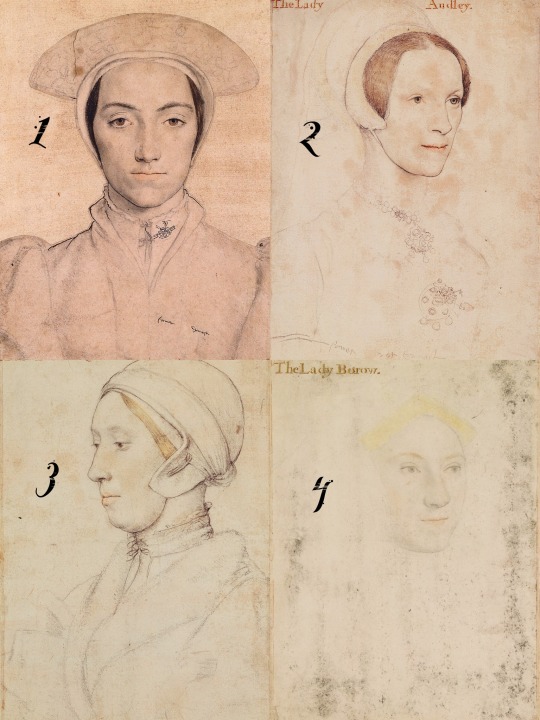
1. The sitter in the portrait is unknown, but it has been suspected to be of Amalia of Cleves, the sister of Anne of Cleves.
2. Elizabeth Audley, the wife of Thomas Audley, 1st Baron Audley of Walden
3. The sitter in the portrait is unknown, but it has been suspect to be of Anne Boleyn.
4. Alice Burgh, the wife of Thomas Burgh who was a part of the household of Prince Edward (later Edward VI).

5. Margaret Butts, a lady-in-waiting to Princess Mary (later Mary I).
6. Anne Cresarce, a ward of Thomas More.
7. Elizabeth Dauncey, a daughter of Thomas More.
8. Margaret, Marchioness of Dorset, a godmother to Princess Elizabeth (later Elizabeth I).
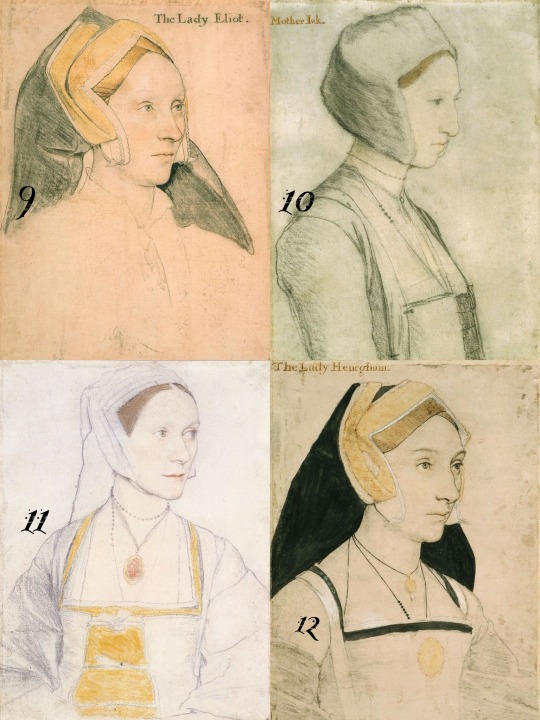
9. Margaret Elyot.
10. Margaret Giggs, a ward of Thomas More.
11. Cicely Heron, a daughter of Thomas More.
12. Mary Heveningham, a first cousin to Anne Boleyn and suspected mistress to Henry VIII.

13. Elizabeth Hoby, was a part of Katherine Parr’s inner circle.
14. The sitter in the portrait is unknown, but it has been suspected to be of Katherine Howard.
15. Frances, Countess of Surrey, the wife of Henry Howard, Earl of Surrey.
16. Mary, Duchess of Richmond and Somerset, the wife of Henry VIII’s illegitimate son Henry Fitzroy.
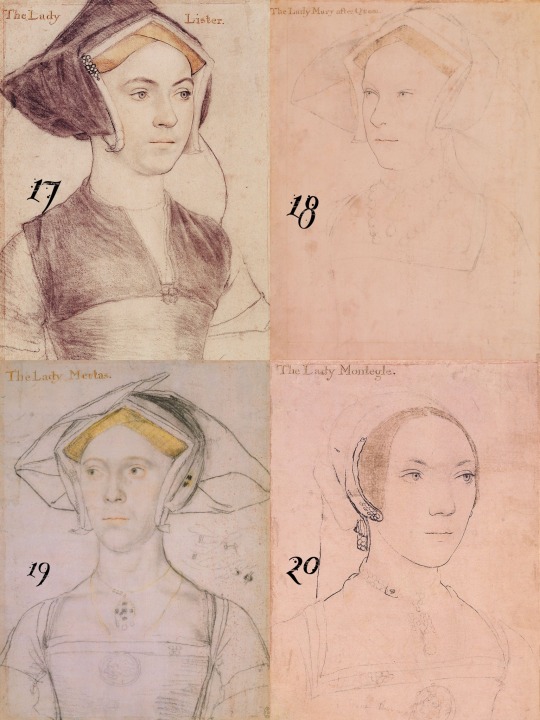
17. Probably of Jane Lister.
18. Princess Mary (later Mary I).
19. Joan Meautas, lady of the privy chamber to Jane Seymour.
20. Mary Monteagle, a daughter of Charles Brandon.
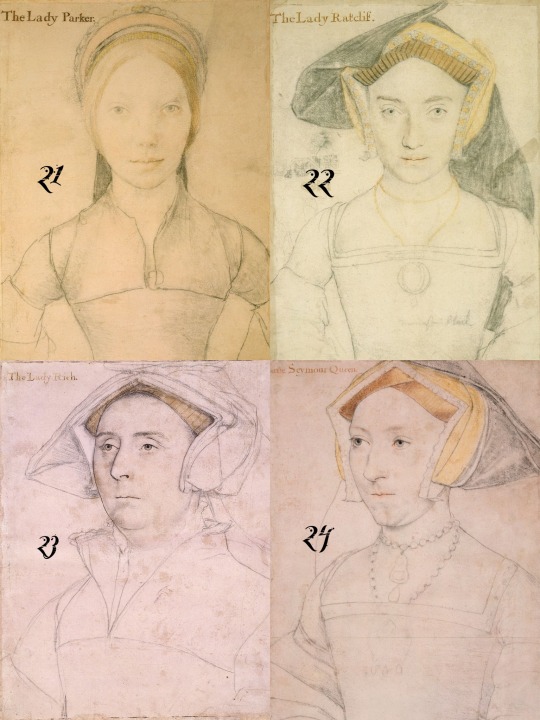
21. Formerly suspected to be of Jane Boleyn, but is now believed to be of Grace Parker.
22. Could be any of the three wives of Robert Radcliffe, 1st Earl of Sussex, but is probably his third wife Mary Arundell.
23. Elizabeth Rich, the wife of Richard Rich, 1st Baron Rich.
24. Jane Seymour.
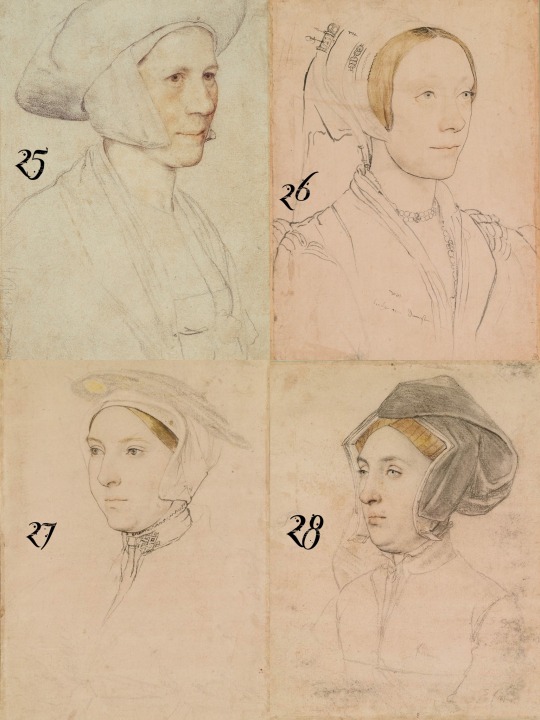
25. Unknown sitter.
26. Unknown sitter.
27. Unknown sitter.
28. Unknown sitter.
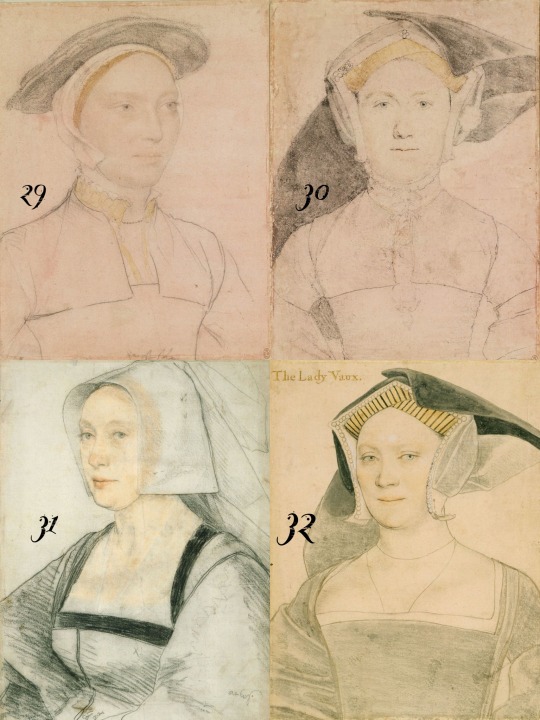
29. Unknown sitter, but has been suspected to be of Anne Herbert, the sister of Katherine Parr.
30. Unknown sitter.
31. Unknown sitter, but has been suspected to be of Maud Green, the mother of Katherine Parr.
32. Elizabeth Vaux, a first cousin to Katherine Parr.
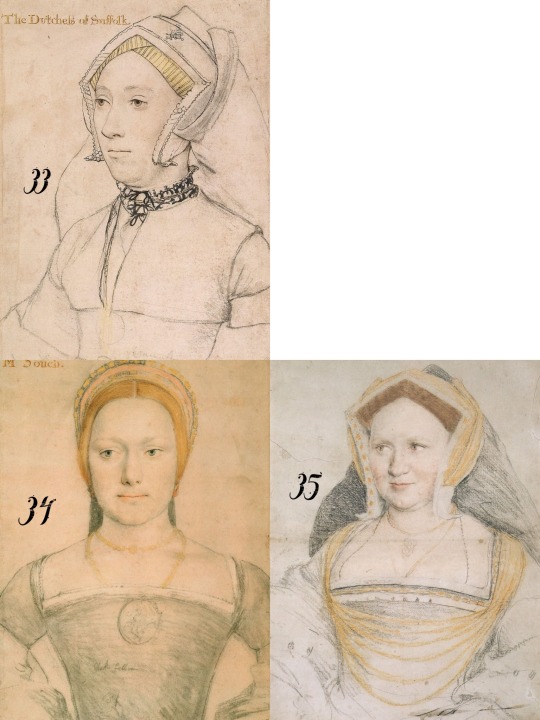
33. Catherine Willoughby, the wife of Charles Brandon.
34. Mary Zouch, a lady-in-waiting to Anne Boleyn.
35. Mary Guilford, the wife of Henry Guilford.
#hans holbein#history#tudor history#anne of cleves#anne boleyn#katherine howard#katherine parr#henry viii#art
2K notes
·
View notes
Note
Do you know anything about this (Holbein?) miniature that's supposed to be Mary I? Thank you.

Well it is not by Holbein, possibly by fallower.
Holbein actually at least towards end of his life(he died in late 1543) had a workshop where more people worked, and while he was doing the sketches, the finished paintings often had more makers. However after he died, without him these people either weren’t able to produce as good work or possibly perished with him and eventually other painters replaced them.
So while on first glance this looks like his work, it is not, and you can tell by the fashion. The high-necked underparlets appeared since at least late 1520s, however they only started to form ruff like edge this much by very end of Henry VIII's life. After Holbein died.
Note that wearer has black string holding the hood under the chin, and black top part. That is highly unsual. While back of french hood the veil was always black-the front(sides or top) not very often. White and red or their combination were more usual, but it can be also that black french hood became more fashionable towards end of Henry VIII’s reign(and that it didn’t signify mourning).
However based upon the shape of french hood, and shape of high necked parlet, we can determine it is at earliest 2nd half 1540s.
I’ve seen the post which spoke about the similiarities between this miniature and that of Edward IV, which Met Museum says is by Holbein’s workshop, done c.1545 and then some alterations occured not long after in c.1547.
I’d say earliest date for the miniature of female would be around c.1546, possibly early 1550s. But does it mean it is Mary?
No! And the same pose is absolutely not solid evidence for it being siblings. It could have just been fashionable pose of the time. And even if there was some resemblence(which imo there isn’t), it could be his other sister or some other female relative of his. Not even necessarly royalty.
I know some webpages claim only royals had their miniature done in Tudor times. But that is a lie! Easily disproven, from top of my head I can name lady Audley’s miniature, Margaret Roper’s-neither was royalty.
Hence it doesn’t even have to necessarily be a royalty, despite the amount of jewels. French hoods weren’t as heavily bejewelled prior either, and clothes could have just fallowed in suite with the trend.
So if you’re asking me-is it Mary? I cannot exclude the possibility, however I think the supposed evidence presented for it is just wishful thinking.
5 notes
·
View notes
Note
Names with similar vibes to Garfield?
whoo! last request in the inbox!
Anthony
Audley
Barney
Benjamin
Barbara
Bobbie
Edward
Eugene
Feilder
Gibson
George
Gordon
Garrison
Harold
Ledrew
Leighton
Merville
Margaret
Marleen
Patricia
Paula
Pauleen / Pauline
Richard
Simone
#same vibes#similar vibes#similar to garfield#read dni#name blog#name ideas#name lists#name suggestions#read my dni#name request#name inspiration#baby names#names like garfield#names similar to garfield#name list#names list
4 notes
·
View notes
Text
TOP 11 EVIL STEPMOTHERS (FROM CINDERELLA)
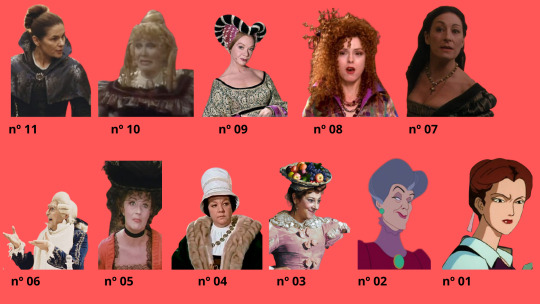
@theancientvaleofsoulmaking @astrangechoiceoffavourites @anne-white-star @superkingofpriderock @sunlit-music @princesssarisa
I ranked the heroes and their main ally. Now i’ts the turn of the villain. Greedy, spitefull, manipulative, envious, Cinderella’s Stepmother is probably one of the most grounded fairy tale villains ever created. Quintessential abusive relative, sometimes only to her stepdaughter, sometimes to her husband, and sometimes even to her own children, we probably will see someone like the Stepmother on the news, and that what makes so frightening for readers and viewers alike. So tonight, i will share the ranking of my favorite portrayals of this villain on screen.
11º Barbara Rauer as the Stepmother in Sechs Auf Einen Streich (2011)
This version of the Stepmother is extablished pretty early to be simply mean. Not only will she exploit and humiliate her stepdaughter, but she also denies a servant to see her ill brother unless Cinderella covers her work, and puts her daughter’s feet in the most unconfortable shoes ever just they are beautifull and will atract the atention of suitors. Plus, she is one of the few Stepmothers that recognizes Cinderella at the ball and drags her out by the arm, for the poor to be trown at the mud by her daughter. In an age where media started to be dominated by simpathetic, tragic villains, Barbara Rauer’s performance brings to light the charm of a classic villain that delights on being mean, and that is why she enters this ranking.
10º Eve Arden as the Stepmother in Faerie Tale Theatre (1985)
Being fun without intentional effort: at first, this Stepmother begins acting dissimulated, casually trowing all the hardwork over Cinderella’s shoulders while trying to pass as a fair tasks divisionist. But later, she doesn’t need at all to pretend, opting for telling blatantly that she dislikes Cinderella and sees her as competition against her daughters for societal atention and liking. All the while keeping the calm, casual, almost cheery voice tone, wich we can see as the main reason she exerts control over her stepdaughter: no need to treaten, to beat, showing that sometimes the worst abuser is the one with the sweetest voice and smile.
09º Jo Van Fleet as the Stepmother in Rodgers and Hammerstein’s Cinderella (1965)
The lady who wants perfection above all. She wants her daughters to stop having cracking joints and constantly twinkling their eyes, and to be eloquent in conversations so they can impress rich, noble suitors. Unfortunally for her, she has to learn that without virtues like kindness and honesty, those things that she considers synonimus with perfection become empty and superficial.
08º Bernadette Peters as the Stepmother in Rodgers and Hammerstein’s Cinderella (1997)
Perfectionism mixed with the drama of a stage diva. Peters’s Stepmother feels like an aging star, who is desperate in clinging to her youth and past glories if the method of using her daughters to achieve her dreams fails. The highlight of this version is when she dramatically asks to try the glass slipper, hoping for a chance to marry the Prince herself.
07º Angelica Houston as Baroness Rodmilla de Ghent in Ever After: A Cinderella Story (1998)
Baroness Rodmilla de Ghent once acted in a nice way, years ago, before the passing away of her husband. Now, she turned herself into a cruel, bitter person, who besides comiting domestic abuse against her stepdaughter Danielle and putting her daughters Marguerite and Jacqueline to constantly compete against each other, is active in selling people into slavery. All the while keeping a facade of gentle, noble lady.
06º Paolo Montarsolo as Don Magnífico in Jean-Pierre Ponelle’s La Cenerentola (1981)
The time when the Stepmother becamed a Stepfather. What is interesting about Don Magnifíco as a villain is that, while he is not cold and calculating like most portrayals, and is more on the comedic spectrum, he doesn’t stop being cruel and intimidating, letting implied that he beats his stepdaughter Angelina if she disobeys him, constantly complaining about he is frustrated for having daughters instead of sons, and of course there is the fact that he is a man in the 19th century, wich means he would receive more power to handle his stepdaughters money inheritance and the benefit of the doubt from society, who more easily excuse violent man for their horrible behaviour. Don Magnífico is a treat to not be underestimated, wich makes his carmic punishment of bankrupcy even more satisfying to watch.
05º Margaret Lockwood as the Stepmother in The Slipper and The Rose (1976)
One line made Lockwood number five:
“How dare she forgive me”?
It shows that she will never acept Cinderella’s happiness, and probably will still be a pebble on the shoe to be dealt with.
04º Carola Braunbock as the Stepmother in Three Wishes for Cinderella (1973)
Tall, with a sharp eye expression and strong voice, Braunbock’s Stepmother is a villain of comanding and intimidating presence, but who doesn’t necessarily holds all the power and control that she thinks she holds, so it’s fun watching the many times she is outwited.
03º Faina Georgievna Ranevskaya as the Stepmother in Zolushka (1947)
Another comanding and intimidating presence, but who this time holds more control, using treats against her own husband’s well being to treaten Cinderella so she will be compliant to all her demands, including forcing the glass slipper to apparently fit one of her daughters, following to comanding the King’s messengers to march announcing herself as future Royal Mother in Law, before finally receiving the comeupance in form of public humiliation. This is the most proud, loud and pompous encarnation of the Stepmother i ever saw, and this is what makes her one of my favorites. She is like the distant russian cousin of Brian Blessed.
02º Eleanor Audley as Lady Tremaine in Disney’s Cinderella (1950)
My first encarnation of the Stepmother. What can i say about Lady Tremaine that hasn’t been sayed already? She dissimulates the facade of a reasonable autority figure pretty well, her voice is powerfull, and her eye expressions... they give me the chills just thinking about it. This makes her one of my favorite Disney Villains, tough not necessarily my number one encarnation of the Stepmother.
This place actually goes to:
01º Toshiko Sawada as the Duchess in Cinderella Monogatari (1996)
When we first meet the Duchess, she seems a kind, reasonable, if a bit cold, person. It is when her husband has to go for a long travel that she reveals her true face, and even then just to the audience, the animals and the three girls who are under her responsability: she puts Cinderella out of her room so her daughters can take it for themselves, makes her dress rags and gives her lots of heavy work. At one moment, she gets so angry with her stepdaughter that she treatens to push her out of the house, but her daughters convince her not to, because “Who would make the domestic tasks for us”? If that isn’t enough, she went so far as framing Cinderella for stealing grapes from the royal vines. And it only goes downhill from there, while lots of people still believe the Duchess to be a good person, until the Shoe Test happens, she finally gets so desperate that she asks to try the shoe, and a happy ending can finally be reached by the heroine who truly fits the piece of costume.
Dangerously inteligent, dissimulated, ambitious, calculating and cruel till the end, the Duchess was a villain whose pat you always feared to cross, and probably still can, and that is why she is my number one portrayal of the Stepmother.
HONORABLE MENTIONS: Raquel Welch as the Stepmother in Happily Ever After: Fairy Tales for Every Child (1995); Elsa Lanchester as Widow Sonder in The Glass Slipper (1955)
#fairy tales#moodboards#wallpapers#fairytales#fairytale#rankings#cinderella#cinderella 1947#cinderella 1950#cinderella 1965#cinderella 1997#rodgers and hammerstein#zolushka#three wishes for cinderella#cinderella monogatari#the slipper and the rose
42 notes
·
View notes
Text
BOOK RECS
Okay, so lots of people wanted this and so, I am compiling a list of my favourite books (both fiction and non-fiction), books that I recommend you read as soon as humanly possible. In the meantime, I’ll be pinning this post to the top of my blog (once I work out how to do that lmao) so it will be accessible for old and new followers. I’m going to order this list thematically, I think, just to keep everything tidy and orderly. Of course, a lot of this list will consist of historical fiction and historical non-fiction because that’s what I read primarily and thus, that’s where my bias is, but I promise to try and spice it up just a little bit.
Favourite fiction books of all time:
The Mermaid and Mrs Hancock // Imogen Hermes Gowar
Sense and Sensibility // Jane Austen
Slammerkin // Emma Donoghue
Remarkable Creatures // Tracy Chevalier
Life Mask // Emma Donoghue
His Dark Materials // Philip Pullman (this includes the follow-up series The Book of Dust)
Emma // Jane Austen
The Miniaturist // Jessie Burton
Girl, Woman, Other // Bernadine Evaristo
Jane Eyre // Charlotte Brontë
Persuasion // Jane Austen
Girl with a Pearl Earring // Tracy Chevalier
The Silent Companions // Laura Purcell
Tess of the d’Urbervilles // Thomas Hardy
Northanger Abbey // Jane Austen
The Chronicles of Narnia // C.S. Lewis
Pride and Prejudice // Jane Austen
Goodnight, Mr Tom // Michelle Magorian
The French Lieutenant’s Woman // John Fowles
The Butcher’s Hook // Janet Ellis
Mansfield Park // Jane Austen
The All Souls Trilogy // Deborah Harkness
The Railway Children // Edith Nesbit
Favourite non-fiction books of all time
Catherine the Great: Portrait of a Woman // Robert Massie
Love and Louis XIV: The Women in the Life of the Sun King // Antonia Fraser
Madame de Pompadour // Nancy Mitford
The First Iron Lady: A Life of Caroline of Ansbach // Matthew Dennison
Black and British: A Forgotten History // David Olusoga
Courtiers: The Secret History of the Georgian Court // Lucy Worsley
Young and Damned and Fair: The Life of Katherine Howard, the Fifth Wife of Henry VIII // Gareth Russell
King Charles II // Antonia Fraser
Casanova’s Women // Judith Summers
Marie Antoinette: The Journey // Antonia Fraser
Mrs. Jordan’s Profession: The Story of a Great Actress and a Future King // Claire Tomalin
Jane Austen at Home // Lucy Worsley
Mudlarking: Lost and Found on the River Thames // Lara Maiklem
The Last Royal Rebel: The Life and Death of James, Duke of Monmouth // Anna Keay
The Marlboroughs: John and Sarah Churchill // Christopher Hibbert
Nell Gwynn: A Biography // Charles Beauclerk
Jurassic Mary: Mary Anning and the Primeval Monsters // Patricia Pierce
Georgian London: Into the Streets // Lucy Inglis
The Prince Who Would Be King: The Life and Death of Henry Stuart // Sarah Fraser
Wedlock: How Georgian Britain’s Worst Husband Met His Match // Wendy Moore
Dead Famous: An Unexpected History of Celebrity from the Stone Age to the Silver Screen // Greg Jenner
Victorians Undone: Tales of the Flesh in the Age of Decorum // Kathryn Hughes
Crown of Blood: The Deadly Inheritance of Lady Jane Grey // Nicola Tallis
Favourite books about the history of sex and/or sex work
The Origins of Sex: A History of First Sexual Revolution // Faramerz Dabhoiwala
Erotic Exchanges: The World of Elite Prostitution in Eighteenth-Century Paris // Nina Kushner
Peg Plunkett: Memoirs of a Whore // Julie Peakman
Courtesans // Katie Hickman
The Other Victorians: A Study of Sexuality and Pornography in mid-Nineteenth Century England
Madams, Bawds, and Brothel Keepers // Fergus Linnane
The Secret History of Georgian London: How the Wages of Sin Shaped the Capital // Dan Cruickshank
A Curious History of Sex // Kate Lister
Sex and Punishment: 4000 Years of Judging Desire // Eric Berkowitz
Queen of the Courtesans: Fanny Murray // Barbara White
Rent Boys: A History from Ancient Times to Present // Michael Hone
Celeste // Roland Perry
Sex and the Gender Revolution // Randolph Trumbach
The Pleasure’s All Mine: A History of Perverse Sex // Julie Peakman
LGBT+ fiction I love*
The Confessions of the Fox // Jordy Rosenberg
As Meat Loves Salt // Maria Mccann
Bone China // Laura Purcell
Brideshead Revisited // Evelyn Waugh
The Confessions of Frannie Langton // Sara Collins
The Intoxicating Mr Lavelle // Neil Blackmore
Orlando // Virginia Woolf
Tipping the Velvet // Sarah Waters
She Rises // Kate Worsley
The Mercies // Kiran Millwood Hargrave
Oranges are Not the Only Fruit // Jeanette Winterson
Maurice // E.M Forster
Frankisstein: A Love Story // Jeanette Winterson
If I Was Your Girl // Meredith Russo
The Well of Loneliness // Radclyffe Hall
* fyi, Life Mask and Girl, Woman, Other are also LGBT+ fiction
Classics I haven’t already mentioned (including children’s classics)
Far From the Madding Crowd // Thomas Hardy
I Capture the Castle // Dodie Smith
Vanity Fair // William Makepeace Thackeray
Wuthering Heights // Emily Brontë
The Blazing World // Margaret Cavendish, Duchess of Newcastle
Murder on the Orient Express // Agatha Christie
Great Expectations // Charles Dickens
North and South // Elizabeth Gaskell
Evelina // Frances Burney
Death on the Nile // Agatha Christie
The Monk // Matthew Lewis
Frankenstein // Mary Shelley
Vilette // Charlotte Brontë
The Mayor of Casterbridge // Thomas Hardy
The Tenant of Wildfell Hall // Anne Brontë
Vile Bodies // Evelyn Waugh
Beloved // Toni Morrison
The Murder of Roger Ackroyd // Agatha Christie
The History of Tom Jones, A Foundling // Henry Fielding
A Room With a View // E.M. Forster
Silas Marner // George Eliot
Jude the Obscure // Thomas Hardy
My Man Jeeves // P.G. Wodehouse
Lady Audley’s Secret // Mary Elizabeth Braddon
Middlemarch // George Eliot
Little Women // Louisa May Alcott
Children of the New Forest // Frederick Marryat
I Know Why the Caged Bird Sings // Maya Angelou
Rebecca // Daphne du Maurier
Alice in Wonderland // Lewis Carroll
The Wind in the Willows // Kenneth Grahame
Anna Karenina // Leo Tolstoy
Howard’s End // E.M. Forster
The Secret Diary of Adrian Mole, Aged 13 3/4 // Sue Townsend
Even more fiction recommendations
The Darling Strumpet // Gillian Bagwell
The Wolf Hall trilogy // Hilary Mantel
The Illumination of Ursula Flight // Anne-Marie Crowhurst
Queenie // Candace Carty-Williams
Forever Amber // Kathleen Winsor
The Corset // Laura Purcell
Love in Colour // Bolu Babalola
Artemisia // Alexandra Lapierre
Blackberry and Wild Rose // Sonia Velton
The Bloody Chamber and Other Stories // Angela Carter
The Languedoc trilogy // Kate Mosse
Longbourn // Jo Baker
A Skinful of Shadows // Frances Hardinge
The Black Moth // Georgette Heyer
The Far Pavilions // M.M Kaye
The Essex Serpent // Sarah Perry
The Seven Husbands of Evelyn Hugo // Taylor Jenkins Reid
Cavalier Queen // Fiona Mountain
The Winter Palace // Eva Stachniak
Friday’s Child // Georgette Heyer
Falling Angels // Tracy Chevalier
Little // Edward Carey
Chocolat // Joanne Harris
The Watchmaker of Filigree Street // Natasha Pulley
My Sister, the Serial Killer // Oyinkan Braithwaite
The Convenient Marriage // Georgette Heyer
Katie Mulholland // Catherine Cookson
Restoration // Rose Tremain
Meat Market // Juno Dawson
Lady on the Coin // Margaret Campbell Bowes
In the Company of the Courtesan // Sarah Dunant
The Crimson Petal and the White // Michel Faber
A Place of Greater Safety // Hilary Mantel
The Little Shop of Found Things // Paula Brackston
The Improbability of Love // Hannah Rothschild
The Murder Most Unladylike series // Robin Stevens
Dark Angels // Karleen Koen
The Words in My Hand // Guinevere Glasfurd
Time’s Convert // Deborah Harkness
The Collector // John Fowles
Vivaldi’s Virgins // Barbara Quick
The Foundling // Stacey Halls
The Phantom Tree // Nicola Cornick
The Seven Deaths of Evelyn Hardcastle // Stuart Turton
Golden Hill // Francis Spufford
Assorted non-fiction not yet mentioned
The Dinosaur Hunters: A True Story of Scientific Rivalry and the Discovery of the Prehistoric World // Deborah Cadbury
The Beauty and the Terror: An Alternative History to the Italian Renaissance // Catherine Fletcher
All the King's Women: Love, Sex, and Politics in the life of Charles II // Derek Jackson
Mozart’s Women // Jane Glover
Scandalous Liaisons: Charles II and His Court // R.E. Pritchard
Matilda: Queen, Empress, Warrior // Catherine Hanley
Black Tudors // Miranda Kaufman
To Catch a King: Charles II's Great Escape // Charles Spencer
1666: Plague, War and Hellfire // Rebecca Rideal
Henrietta Maria: Charles I's Indomitable Queen // Alison Plowden
Catherine of Braganza: Charles II's Restoration Queen // Sarah-Beth Watkins
Four Sisters: The Lost Lives of the Romanov Grand Duchesses // Helen Rappaport
Aristocrats: Caroline, Emily, Louisa and Sarah Lennox, 1740-1832 // Stella Tillyard
The Fortunes of Francis Barber: The True Story of the Jamaican Slave who Became Samuel Johnson’s Heir // Michael Bundock
Black London: Life Before Emancipation // Gretchen Gerzina
In These Times: Living in Britain Through Napoleon’s Wars, 1793-1815
The King’s Mistress: Scandal, Intrigue and the True Story of the Woman who Stole the Heart of George I // Claudia Gold
Perdita: The Life of Mary Robinson // Paula Byrne
The Gentleman’s Daughter: Women’s Lives in Georgian England // Amanda Vickery
Terms and Conditions: Life in Girls’ Boarding School, 1939-1979 // Ysenda Maxtone Graham
Fanny Burney: A Biography // Claire Harman
Aphra Behn: A Secret Life // Janet Todd
The Imperial Harem: Women and the Sovereignty in the Ottoman Empire // Leslie Peirce
The Fall of the House of Byron // Emily Brand
The Favourite: Sarah, Duchess of Marlborough // Ophelia Field
Night-Walking: A Nocturnal History of London // Matthew Beaumont, Will Self
Jane Austen: A Life // Claire Tomalin
Beloved Emma: The Life of Emma, Lady Hamilton // Flora Fraser
Sentimental Murder: Love and Madness in the 18th Century // John Brewer
Henrietta Howard: King’s Mistress, Queen’s Servant // Tracy Borman
City of Beasts: How Animals Shaped Georgian London // Tom Almeroth-Williams
Queen Anne: The Politics of Passion // Anne Somerset
Charlotte Brontë: A Life // Claire Harman
Goddess: The Secret Lives of Marilyn Monroe // Anthony Summers
Queer City: Gay London from the Romans to the Present Day // Peter Ackroyd
Elizabeth I and Her Circle // Susan Doran
African Europeans: An Untold History // Olivette Otele
Young Romantics: The Shelleys, Byron, and Other Tangled Lives // Daisy Hay
How to Create the Perfect Wife // Wendy Moore
The Sphinx: The Life of Gladys Deacon, Duchess of Marlborough // Hugo Vickers
The Life and Death of Anne Boleyn // Eric Ives
Dancing in the Streets: A History of Collective Joy // Barbara Ehrenreich
A is for Arsenic: The Poisons of Agatha Christie // Kathryn Harkup
Mistresses: Sex and Scandal at the Court of Charles II // Linda Porter
Female Husbands: A Trans History // Jen Manion
Ladies in Waiting: From the Tudors to the Present Day // Anne Somerset
Ghostland: In Search of a Haunted Country // Edward Parnell
A Cheesemonger’s History of the British Isles // Ned Palmer
The Butchering Art: Joseph Lister’s Quest to Transform the Grisly World of Victorian Medicine // Lindsey Fitzharris
Medieval Woman: Village Life in the Middle Ages // Ann Baer
The Husband Hunters: Social Climbing in London and New York // Anne de Courcy
The Voices of Nîmes: Women, Sex, and Marriage in Reformation Languedoc // Suzannah Lipscomb
The Daughters of the Winter Queen // Nancy Goldstone
Mad and Bad: Real Heroines of the Regency // Bea Koch
Bess of Hardwick // Mary S. Lovell
The Royal Art of Poison // Eleanor Herman
The Strangest Family: The Private Lives of George III, Queen Charlotte, and the Hanoverians // Janice Hadlow
Palaces of Pleasure: From Music Halls to the Seaside to Football; How the Victorians Invented Mass Entertainment // Lee Jackson
Favourite books about current social/political issues (?? for lack of a better term)
Feminism, Interrupted: Disrupting Power // Lola Olufemi
Revolting Prostitutes: The Fight for Sex Worker Rights // Molly Smith, Juno Mac
Why I’m No Longer Talking to White People About Race // Reni Eddo-Lodge
Trans Britain: Our Journey from the Shadows // Christine Burns
Me, Not You: The Trouble with Mainstream Feminism // Alison Phipps
Trans Like Me: A Journey For All Of Us // C.N Lester
Brit(Ish): On Race, Identity, and Belonging // Afua Hirsch
The Brutish Museums: The Benin Bronzes, Colonial Violence, and Cultural Restitution // Dan Hicks
Things No One Will Tell Fat Girls: A Handbook for Unapologetic Living // Jes M. Baker
Hood Feminism: Notes from the Women White Feminists Forgot // Mikki Kendall
Denial: Holocaust History on Trial // Deborah Lipstadt
Yes Means Yes: Visions of Female Sexual Power and a World Without Rape // Jessica Valenti, Jaclyn Friedman
Don’t Touch My Hair // Emma Dabiri
Sister Outsider // Audre Lorde
Unicorn: The Memoir of a Muslim Drag Queen // Amrou Al-Kadhi
Trans Power // Juno Roche
Breathe: A Letter to My Sons // Imani Perry
The Windrush Betrayal: Exposing the Hostile Environment // Amelia Gentleman
Happy Fat: Taking Up Space in a World That Wants to Shrink You // Sofie Hagen
Diaries, memoirs & letters
The Diary of a Young Girl // Anne Frank
Renia’s Diary: A Young Girl’s Life in the Shadow of the Holocaust // Renia Spiegel
Writing Home // Alan Bennett
The Diary of Samuel Pepys // Samuel Pepys
Histoire de Ma Vie // Giacomo Casanova
Toast: The Story of a Boy’s Hunger // Nigel Slater
London Journal, 1762-1763 // James Boswell
The Diary of a Bookseller // Shaun Blythell
Jane Austen’s Letters // edited by Deidre la Faye
H is for Hawk // Helen Mcdonald
The Salt Path // Raynor Winn
The Glitter and the Gold // Consuelo Vanderbilt, Duchess of Marlborough
Journals and Letters // Fanny Burney
Educated // Tara Westover
Bookworm: A Memoir of Childhood Reading // Lucy Mangan
Why Be Happy When You Could Be Normal? // Jeanette Winterson
A Dutiful Boy // Mohsin Zaidi
Secrets and Lies: The Trials of Christine Keeler // Christine Keeler
800 Years of Women’s Letters // edited by Olga Kenyon
Istanbul // Orhan Pamuk
Henry and June // Anaïs Nin
Historical romance (this is a short list because I’m still fairly new to this genre)
The Bridgerton series // Julia Quinn
One Good Earl Deserves a Lover // Sarah Mclean
Nine Rules to Break When Romancing a Rake // Sarah Mclean
The Lady’s Guide to Celestial Mechanics // Olivia Waite
That Could Be Enough // Alyssa Cole
Unveiled // Courtney Milan
The Craft of Love // EE Ottoman
The Maiden Lane series // Elizabeth Hoyt
An Extraordinary Union // Alyssa Cole
Slightly Dangerous // Mary Balogh
Dangerous Alliance: An Austentacious Romance // Jennieke Cohen
A Fashionable Indulgence // KJ Charles
#the only categories not on here are plays and poetry#just bc this post would be even longer!#you can ask me for my favourite playwrights/poets separately tho
186 notes
·
View notes
Text
A brown moth fluttered.
The curtain was down, and the carpenters were rearranging the “No, no, no! I can’t breathe 1 volatile I can’t breathe.” And such a fit of suffocating 2 “I can’t breathe,” she would sometimes say 3 and the minisnever! I can’t breathe it in fast enough, nor hard enough, nor long enough.” 4 and started up up. to return to the tent, only to check him No, I can’t breathe the same air self in the act as often as he started, with ye to-night, but ye’ll go into the he lost consciousness in uneasy dreams 5 meet me at the station. I can’t breathe in this wretched 6 “sickening down there — I can’t breathe! I can’t stand it, Drewe! It’s killing me!” — Tears 7 struggling to altitudes that I can’t breathe in. I could help him when he was in despair, but he is the sort who 8 sometimes I find I can’t breathe in it. Perhaps some folks will say “so much the worse for you” 9 it seems if I can’t breathe in the house. not dared hope 10 “Well, I won’t wear ’em. I can’t breathe” “Sure! Blame ’em!” “I can’t breathe a square breath.” Oh 11 things I regret I can’t breathe. 12 bramble bush. I can’t breathe. I can’t eat. I can’t do anything much. It’s clear to my knees. 13 I can't breathe, I can't talk, 14 lying on its “I can’t stay here I can’t breathe” side, the cork half-loosened. A brown moth fluttered. 15 “I can’t breathe beside you.” 16 the needs of any reasonable young lady. “I can't breathe there, 17 I can’t breathe — I really need the rush of this wintry air to restore me!” 18 I can’t breathe no more in that coop upstairs . tablet ; two he said is what you need.” of flame shoots through a stream of oil 19 no friction. It’s friction—rub- / asthmatically.] “I can’t breathe deep — I can light and of reason. But I’ve a notion 20 out of it. I can’t breathe in the dark. I can’t. I / She withdrew 21 “I can’t breathe or feel in” 22 Up a flight of stairs, and there was the girl, sitting on the edge of an untidy bed. The yellow sweater was on the floor. She had on an underskirt and a pink satin camisole. “I can't breathe !” she gasped. 23 I can’t breathe in the dark! I can’t! I can’t! I can’t live in the dark with my eyes open! 24 One never gets it back! How could one! And I can’t breathe just now, on account of 25 that old stuff, I could shriek. I can’t breathe in the same room with you. The very sound of 26 don’t! I can’t — breathe.... I’m all — and bitter howling. 27
sources (pre-1923; approximately 90 in all, from which these 27 passages, all by women)
1 ex “Her Last Appearance,” in Peters’ Musical Monthly, And United States Musical Review 3:2 (New-York, February 1869), “from Belgravia” : 49-52 (51) “Her Last Appearance” appeared later, “by the author of Lady Audley’s Secret” (M.E. Braddon, 1835-1915 *), in Belgravia Annual (vol. 31; Christmas 1876) : 61-73 2 snippet view ex The Lady’s Friend (1873) : 15 evidently Frances Hodgson Burnett (1849-1924 *) her Vagabondia : A Love Story (New York, 1891) : 286 (Boston, 1884) : 286 (hathitrust) 3 ex “The Story of Valentine; and his Brother.” Part VI. Blackwood’s Edinburgh Magazine vol. 115 (June 1874) : 713-735 (715) authored by Mrs. [Margaret] Oliphant (1828-97 *), see her The Story of Valentine (1875; Stereotype edition, Edinburgh and London, 1876) : 144 4 OCR confusions at Olive A. Wadsworth, “Little Pilkins,” in Sunday Afternoon : A Monthly Magazine for the Household vol. 2 (July-December 1878) : 73-81 (74) OAW “Only A Woman” was a pseudonym of Katharine Floyd Dana (1835-1886), see spoonercentral. Katharine Floyd Dana also authored Our Phil and Other Stories (Boston and New York, 1889) : here, about which, a passage from a bookseller's description — Posthumously published fictional sketches of “negro character,” first published in the Atlantic Monthly under the pseudonym Olive A. Wadsworth. The title story paints a picture of plantation life Dana experienced growing up on her family’s estate in Mastic, Long Island. Although a work of fiction set in Maryland, the character of Phil may of been named for a slave once jointly owned by the Floyds and a neighboring family. source see also the William Buck and Katherine Floyd Dana collection, 1666-1912, 1843-1910, New York State Historical Documents (researchworks). 5 OCR cross-column misread, at M(ary). H(artwell). Catherwood (1847-1902 *), “The Primitive Couple,” in Lippincott’s Magazine of Popular Literature and Science 36 (August 1885) : 138-146 (145) author of historical romances, short stories and poetry, and dubbed the “Parkman of the West,” her papers are at the Newberry Library (Chicago) 6 ex Marie Corelli (Mary Mackay; 1855-1924 *), Thelma, A Norwegian Princess: A Novel, Book II. The Land of Mockery. Chapter 12 (New Edition, London, 1888) : 432 7 preview snippet (only), at Ada Cambridge (1844-1926 *), Fidelis, a Novel ( “Cheap Edition for the Colonies and India,” 1895) : 289 full scan, (New York, 1895) : 261 born and raised in England, spent much of her life in Australia (died in Melbourne); see biography (and 119 of her poems) at the Australia Poetry Library in particular, the striking poems from Unspoken Thoughts (1887) here (Thomas Hardy comes to mind) 8 snippet view (only) at F(rances). F(rederica), Montrésor (1862-1934), At the Cross-Roads (London, 1897) : 297 but same page (and scan of entirety) at hathitrust see her entry At the Circulating Library (Database of Victorian Fiction 1837-1901) an interesting family. Montrésor’s The Alien: A Story of Middle Age (1901) is dedicated to her sister, C(harlotte). A(nnetta). Phelips (1858-1925), who was devoted to work for the blind. See entry in The Beacon, A Monthly magazine devoted to the interests of the blind (May 1925) a great-granddaughter of John Montresor (1737-99), a British military engineer and cartographer, whose colorful (and unconventional) life is sketched at wikipedia. 9 Alice H. Putnam, “An Open Letter,” in Kindergarten Review 9:5 (Springfield, Massachusetts; January 1899) : 325-326 Alice Putnam (1841-1919) opened the first private kindergarten in Chicago; Froebel principles... (wikipedia); see also “In Memory of Alice H. Putnam” in The Kindergarten-primary Magazine 31:7 (March 1919) : 187 (hathitrust) 10 OCR cross-column misread, at Mabel Nelson Thurston (1869?-1965?), “The Palmer Name,” in The Congregationalist and Christian World 86:30 (27 July 1901) : 134-135 author of religiously inflected books (seven titles at LC); first female admitted for entry at George Washington University (in 1888). GWU archives 11 OCR cross-column misread, at Margaret Grant, “The Romance of Kit Dunlop,” Beauty and Health : Woman’s Physical Development 7:6 (March 1904): 494-501 (499 and 500) the episodic story starts at 6:8 (November 1903) : 342 12 ex Marie van Vorst (1867-1936), “Amanda of the Mill,” The Bookman : An illustrated magazine of literature and life 21 (April 1905) : 190-209 (191) “writer, researcher, painter, and volunteer nurse during World War I.” wikipedia 13 ex Maude Morrison Huey, “A Change of Heart,” in The Interior (The sword of the spirit which is the Word of God) 36 (Chicago, April 20, 1905) : 482-484 (483) little information on Huey, who is however mentioned in Paula Bernat Bennett, her Poets in the Public Sphere : The Emancipatory Project of American Women's Poetry, 1800-1900 (2003) : 190 14 ex Leila Burton Wells, “The Lesser Stain,” The Smart Set, A Magazine of Cleverness 19:3 (July 1906) : 145-154 (150) aside — set in the Philippines, where “The natives were silent, stolid, and uncompromising.” little information on Wells, some of whose stories found their way to the movie screen (see IMDB) The Smart Set ran from March 1900-June 1930; interesting story (and decline): wikipedia 15 OCR cross-column misread, at Josephine Daskam Bacon (1876-1961 *), “The Hut in the Wood: A Tale of the Bee Woman and the Artist,” in Collier’s, The National Weekly 41:12 (Saturday, June 13, 1908) : 12-14 16 ex E. H. Young, A Corn of Wheat (1910) : 90 Emily Hilda Daniell (1880-1949), novelist, children’s writer, mountaineer, suffragist... wrote under the pseudonym E. H. Young. (wikipedia) 17 ex Mary Heaton Vorse (1874-1966), “The Engagements of Jane,” in Woman’s Home Companion (May 1912) : 17-18, 92-93 Illustrated by Florence Scovel Shinn (1871-1940, artist and book illustrator who became a New Thought spiritual teacher and metaphysical writer in her middle years. (wikipedia)) Mary Heaton Vorse — journalist, labor activist, social critic, and novelist. “She was outspoken and active in peace and social justice causes, such as women's suffrage, civil rights, pacifism (such as opposition to World War I), socialism, child labor, infant mortality, labor disputes, and affordable housing.” (wikipedia). 18 ex snippet view, at “Voices,” by Runa, translated for the Companion by W. W. K., in Lutheran Companion 20:3 (Rock Island, Illinois; Saturday, January 20, 1912) : 8 full view at hathitrust same passage in separate publication as Voices, By Runa (pseud. of E. M. Beskow), from the Swedish by A. W. Kjellstrand (Rock Island, Illinois, 1912) : 292 E(lsa). M(aartman). Beskow (1874-1953), Swedish author and illustrator of children’s books (Voices seems rather for older children); see wikipedia 19 ex Fannie Hurst (1885-1968 *), “The Good Provider,” in The Saturday Evening Post 187:1 (August 15, 1914) : 12-16, 34-35 20 OCR cross-column misread, at Anne O’Hagan, “Gospels of Hope for Women: A few new creeds, all of them modish—but expensive” in Vanity Fair (February 1915) : 32 Anne O’Hagan Shinn (1869-1933) — feminist, suffragist, journalist, and writer of short stories... “known for her writings detailing the exploitation of young women working as shop clerks in early 20th Century America... O’Hagan participated in several collaborative fiction projects...” (wikipedia) a mention of St. Anselm, whose “sittings” are free, vis-à-vis “Swami Bunkohkahnanda”... “Universal Harmonic Vibrations”... 21 OCR cross-column misread (three columns), at Fannie Hurst (1885-1968 *), “White Goods” (Illustrations by May Wilson Preston) in Metropolitan Magazine 42:3 (July 1915) : 19-22, 53 repeated, different source and without OCR misread, at 24 below 22 ex Mary Patricia Willcocks, The Sleeping Partner (London, 1919) : 47 (snippet only) full at hathitrust see onlinebooks for this and other of her titles. something on Mary Patricia Willcocks (1869-1952) at ivybridge-heritage. in its tone and syntax, her prose brings Iris Murdoch to mind. 23 Katharine Wendell Pedersen, “Clingstones, A week in a California cannery.” in New Outlook vol. 124 (February 4, 1920) : 193-194 no information about the author. the journal began life as The Christian Union (1870-1893) and continued under the new title into 1928; it ceased publication in 1935; it was devoted to social and political issues, and was against Bolshevism (wikipedia) 24 ex Fannie Hurst (1885-1968 *), “White Goods,” in her Humoresque : A Laugh on Life with a Tear Behind it (1919, 1920) : 126-169 (155) 25 ex snippet view, at Letters and poems of Queen Elisabeth (Carmen Sylva), with an introduction and notes by Henry Howard Harper. Volume 2 (of 2; Boston, Printed for members only, The Bibliophile society, 1920) : 51 (hathitrust) Carmen Sylva was “the pen name of Elisabeth, queen consort of Charles I, king of Rumania” (1843-1916 *) 26 OCR cross-column misread, at Ruth Comfort Mitchell, “Corduroy” (Part Three; Illustrated by Frederick Anderson), in Woman’s Home Companion 49:8 (August 1922) : 21-23, 96-97 (hathitrust) Ruth Comfort Mitchell Young (1882-1954), poet, dramatist, etc., and owner of a remarkable house (in a “Chinese” style) in Los Gatos, California (wikipedia) 27 Helen Otis, “The Christmas Waits,” in Woman’s Home Companion 49:12 (Christmas 1922) : 36 probably Helen Otis Lamont (1897-1993), about whom little is found, save this “Alumna Interview: Helen Otis Lamont, Class of 1916” (Packer Collegiate Institute, Brooklyn, 1988) at archive.org (Brooklyn Historical Society)
—
prompted by : recent thoughts about respiration (marshes, etc.); Pfizer round-one recovery focus on the shape of one breath, then another; inhalation, exhalation and the pleasure of breathing; and for whom last breaths are no pleasure (far from it); last breaths (Robert Seelthaler The Field (2021) in the background).
1 of n
all tagged breath all tagged cento
15 notes
·
View notes
Text
MY THREE SONS at 60!
September 29, 1960

“My Three Sons” was a situation comedy produced at Desilu Studios. It premiered on ABC TV on September 29, 1960 and finished its first run on April 13, 1972, with 380 episodes making it the second-longest running live-action sitcom in TV history after “The Adventures of Ozzie and Harriett” (1952-66).

Seasons 1 through 5 were aired in black and white on CBS. In 1965 it moved to CBS when ABC declined to underwrite the costs of airing in color. The series was initially filmed at Desilu Studios in Hollywood, but at the start of the 1967–68 season, the cast and crew began filming the series at the CBS Studio Center in Studio City, California due to Lucille Ball’s sale of Desilu to Gulf + Western, which owned Paramount Pictures. The sale also affected the filming location of another family sitcom, “Family Affair.”
Incredibly, “My Three Sons” ran concurrently through both “The Lucy Show” and “Here’s Lucy.” Both Steve Douglas and Lucy Carmichael (and later Carter), where single parents raising children.
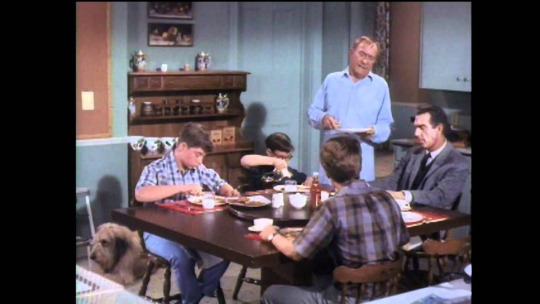
September 16, 1965 was a big night for CBS airing the very first episode of “My Three Sons” after moving from ABC titled “The First Marriage”. It was also the first episode of the series broadcast in color, something “The Lucy Show” did three days earlier with “Lucy at Marineland” (TLS S4;E1). The premise of the series is a widowed father (Steven Douglas) raising his three boys with help of his extended family. Initially, the three sons were Chip, Robbie, and Mike, but in 1967 Mike was written out and replaced by Ernie, whom Steve adopted. The extended family at first consisted of Bub, Steve’s father-in-law and the boys’ maternal grandfather, but in 1964, that character was replaced by Uncle Charley, Steve’s uncle and Bub’s brother.
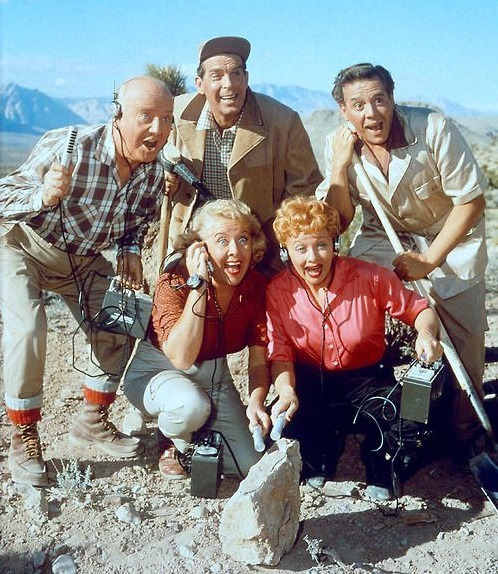
The leading role was played by film star Fred MacMurray, who the series was built around - including his hectic schedule. To suit MacMurray, scenes would be shot out of sequence and even alone on a soundstage and later edited to create a complete episode. This was not MacMurray’s first time at Desilu. In 1958 he played himself on the “Lucy-Desi Comedy Hour” in “Lucy Hunts Uranium” set in the Nevada desert outside Las Vegas. He was joined by his second wife, actress June Haver. MacMurray (1908-91) appeared in over 100 films in his career but is perhaps best remembered for the film Double Indemnity (1944), which Lucy references in this episode. MacMurray’s name was first mentioned by Ethel in 1953 in “The Black Eye” (ILL S2;E20) when flowers arrive for Lucy mistakenly signed “Eternally yours, Fred.”
Although Lucille Ball was their landlord (and ultimate boss) she never acted on the show, but many of the actors who appeared on Lucille Ball’s sitcoms did appear on “My Three Sons”.

From 1960 to 1965, MacMurray was joined by William Frawley as Bub O’Casey, the family’s live-in maternal grandfather. Of course, Frawley came to fame on “I Love Lucy” as the crusty landlord Fred Mertz. Frawley had worked with MacMurray in the 1935 film, Car 99. When Frawley had to leave the show due to ill-health (and it was too costly to insure him) he was replaced by another Desilu alumni, William Demarest, as Uncle Charley. Like his previous co-star, Vivian Vance, Frawley was not especially fond of Demarest personally or as an actor. Demarest had, however, done three films with Lucille Ball. Frawley kept watching “My Three Sons” on his TV set bitterly. He never really got over being replaced by Demarest. On March 3, 1966, Frawley died of a heart attack.

For Christmas 1959, Frawley and Demarest both appeared with Lucy and Desi in “The Desilu Revue” (above with “December Bride’s” Spring Byington). At the time, Demarest was working on the Desilu lot appearing in NBC’s “Love and Marriage.”

On “My Three Sons” two of Steve Douglas’ boys had been seen on “The Lucy Show”: Don Grady (Robbie Douglas) had played Chris Carmichael’s friend Bill and Barry Livingston (Ernie Douglas) had played Mr. Mooney’s son Arnold. Ted Eccles, who assumed the role of Arnold Mooney when Barry Livingston was busy on “My Three Sons,” also did an episode.
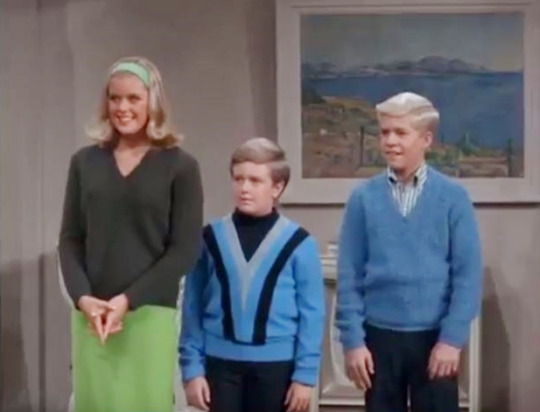
The children of “The Lucy Show,” Ralph Hart (who played Viv Bagley’s son Sherman), Jimmy Garrett (Jerry Carmichael), and Candy Moore (Lucy Carmichael’s daughter Chris) were also on episodes of "My Three Sons.”
Other “Lucy” performers who were on “My Three Sons” include:
Mary Wickes ~ Jeri Schronk (1964)
Doris Singleton ~ Helen & Margaret, 8 episodes (1964-70)
Shirley Mitchell ~ Sally, 2 episodes (1968)
Barbara Pepper ~ Mrs. Brand (1966)
Verna Felton ~ Mub (1962)
Kathleen Freeman ~ Lady Checker (1967)
Jerry Hausner ~ Various Characters, 2 episodes (1964 & 1966)
Reta Shaw ~ Various Characters, 2 episodes (1962 & 1965)
Elvia Allman ~ Maude Prosser (1967)
Eleanor Audley ~ Mrs. Vincent, 9 episodes (1969-70)
Burt Mustin ~ Various Characters, 5 episodes (1962-70)
Olan Soule ~ Various Characters, 5 episodes (1963-70)
Alberto Morin ~ Professor Madoro (1967)
Herb Vigran ~ Caretaker (1967)
Maurice Marsac ~ Various Characters, 3 episodes (1964-72)
Tim Mathewson ~ Various Characters, 3 episodes (1962-63)
Bill Quinn ~ Doctors, 4 episodes (1964-66)
Barbara Perry ~ Mrs. Thompson & Mrs. Hoover, 3 episodes (1964-72)
Nancy Kulp ~ Various Characters, 2 episodes (1962)
George N. Neise ~ Various Characters, 2 episodes (1960 & 1967)
Maxine Semon ~ Various Characters, 2 episodes (1964 & 1967)
Roy Roberts ~Various Characters, 2 episodes (1965 & 1967)
Lou Krugman ~ Various Characters, 2 episodes (1966 & 1967)
Richard Reeves ~ Various Characters, 2 episodes (1962 & 1965)
Dorothy Konrad ~ Various Characters, 2 episodes (1961 & 1962)
Ed Begley ~ Various Characters, 2 episodes (1962 & 1968)
Gail Bonney ~ Various Characters, 2 episodes (1965 & 1970)
Rolfe Sedan ~ Various Characters, 2 episodes (1968 & 1971)
Tyler McVey ~ Various Characters, 2 episodes (1962 & 1967)
J. Pat O’Malley ~ Various Characters, 2 episodes (1963 & 1964)
Paul Picerni ~ Various Characters, 2 episodes (1965 & 1967)
Sandra Gould ~ Various Characters, 2 episodes (1963 & 1964)
Richard Deacon ~ Elderly Man (1960)
Mabel Albertson ~ Mrs. Proctor (1964)
Joan Blondell ~ Harriet Blanchard (1965)
Leon Belasco ~ Professor Lombardi (1966)
Dayton Lummis ~ Dr. Blackwood (1963)
Lurene Tuttle ~ Natalie Corcoran (1968)
Robert Foulk ~ Pop Action (1962)
Dick Patterson ~ Bunny Baxter (1963)
Jamie Farr ~ Itchy (1964)
Larry J. Blake ~ Policeman (1968)
Amzie Strickland ~ Cora Dennis (1968)
Barbara Morrison ~ Mrs. Murdock (1969)
Louis Nicoletti ~ Caddy Master (1962)
Frank Gerstle ~ Policeman (1964)
Gil Perkins ~ Painter (1963)
Tommy Ferrell ~ Mr. Griffith (1964)
Eve McVeagh ~ Clara (1966)
Remo Pisani ~ Pepe (1970)
Dub Taylor ~ Judge (1963)
Frank J. Scannell ~ Emcee (1968)
Ray Kellogg ~ Henshaw (1965)
Romo Vincent ~ Charley (1964)
Stafford Repp ~ Sergeant Perkins (1969)
Jay Novello ~ Vincenzo (1966)
Leoda Richards ~ Restaurant Patron (1966)
CHILD STARS!
Other child stars who appeared on “My Three Sons” included Butch Patrick (“The Munsters”), Jay North (“Dennis the Menace”), Oscar-winner Jodie Foster, Angela Cartwright (“Make Room for Daddy”), Flip Mark (”Lassie”), John Walmsley (”The Waltons”), Tony Dow (“Leave It To Beaver”), Erin Moran (“Happy Days”), Maureen McCormick (”The Brady Bunch”), Ann Jillian (Gypsy), and Heather Menzies (The Sound of Music).

On November 22, 1977, ABC TV (and Dick Clark Productions) brought together a reunion of two of television's favorite sitcoms "The Partridge Family" and "My Three Sons." Hosted by Shirley Jones and Fred MacMurray this would be the only time that the surviving cast members would get together to celebrate the series which included clips, a song from David Cassidy, and an update of what each cast member was doing in 1977.

Also in 1977, some of the stars of the series reunited on a morning program titled "The Early Show", including Stanley Livingston (Chip Douglas), Barry Livingston (Ernie Douglas), Tina Cole (Katie Miller Douglas), and Don Grady (Robbie Douglas).
TRIVIA
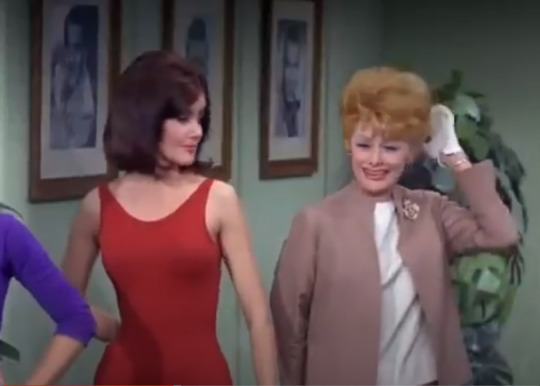
In “Lucy Helps Danny Thomas” (TLS S4;E7) in 1965, there is a large framed photo of Fred MacMurray in the studio hallway. He is joined by other Desilu stars like Jim Nabors (of “Gomer Pyle USMC”), Andy Griffith (of “The Andy Griffith Show”) and Danny Thomas (of “The Danny Thomas Show”).
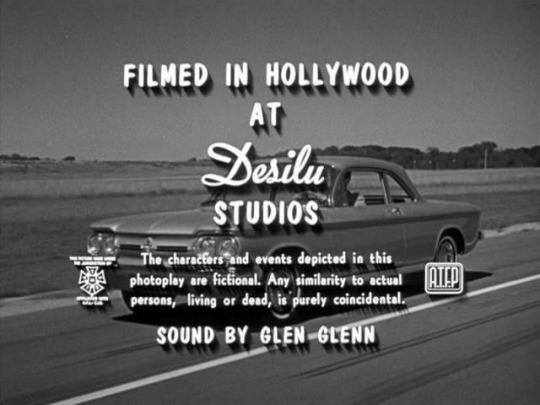
27 notes
·
View notes